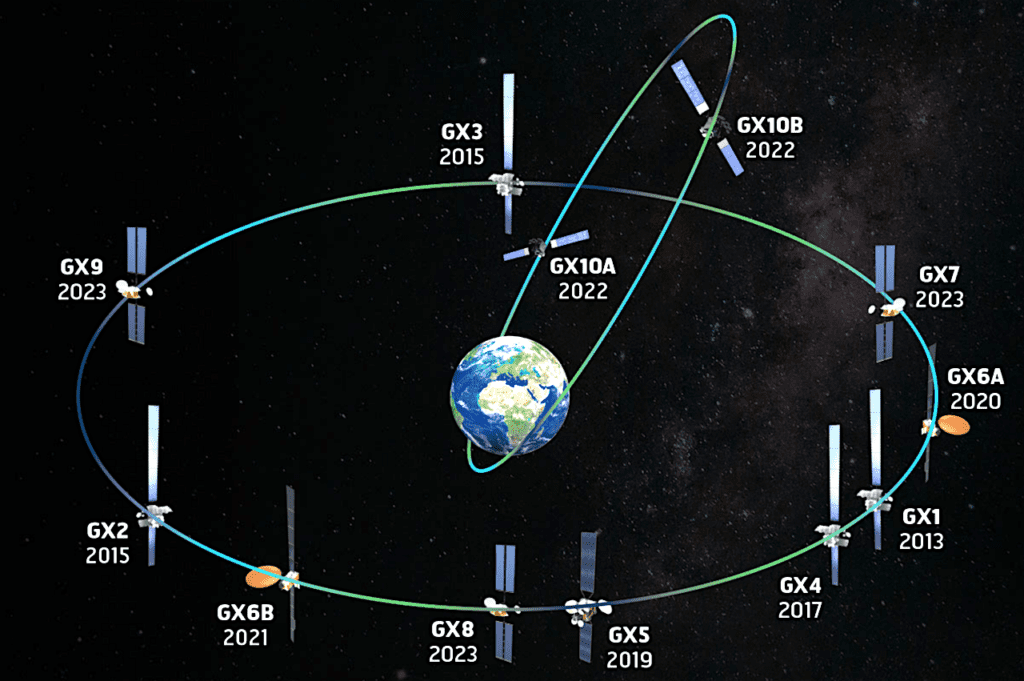
Inmarsat plans to massively expand satellite capacity through 2023 with a focus on aircraft flying in European and Middle Eastern airspace, as well as routes traversing the Arctic region. Photo: Inmarsat
Inmarsat plans to launch eight new satellites by 2023 as part of its future roadmap in a strategic move that will see its support of in-flight connectivity performance and speeds take generational leaps and bring expanded broadband coverage to aircraft flying on Arctic routes.
Inmarsat’s current Global Xpress (GX) network features four geostationary Ka-band satellites in orbit, with a fifth one, GX5, on track to launch by the end of 2019 and provide increased capacity for operators flying in European and Middle Eastern airspace. During the National Business Aviation Association Business Aviation Conference and Exhibition (BACE), the U.K.-based satellite operator released the latest number of business jet operators subscribing to their service, which has now surpassed 600 aircraft installations.
“We will have GX 5 launching later this year, GX 6A and 6B falling in consecutive years after that, and then it gets really exciting when we talk about GX7, 8 and 9. We’ve contracted with Airbus to build 7, 8 and 9, which will become the most technologically advanced satellites for aviation connectivity,” Kai Tang, senior vice president of Inmarsat Aviation told Avionics International.
According to Tang, Inmarsat chose to focus on leveraging GX 5 capacity for Europe and the Middle East because of the growth in demand by aviation and maritime operators in both regions. GX 5 will also be Inmarsat’s first satellite to use V-band as a feeder link.
Tang describes GX 7, 8 and 9 as game changers, that will deliver orders of magnitude of more capacity and give Inmarsat the ability to dynamically adjust capacity and service support based on changes in demand. Those three satellites will provide Inmarsat with the ability to do in-orbit repositioning and direct capacity to high-demand areas such as airports.
A partnership with Space Norway will see the development of GX 10A and 10B, both of which will be placed into highly elliptical orbits (HEO) for coverage of Arctic region flights. The Arctic region satellites carrying the GX payloads will be operated by Space Norway’s Arctic Satellite Broadband Mission team, and are scheduled to launch in 2022, Tang said.
 | Want to hear more on aircraft connectivity applications? Check out the Global Connected Aircraft Podcast, where Avionics editor-in-chief Woodrow Bellamy III interviews airlines and industry influencers on how they’re applying connectivity solutions. |
“GX 10A and 10B are going to be two satellites operating in tandem providing coverage of the Arctic. Everything above the Arctic circle where there’s practically no broadband coverage over that region today. Those flight routes are becoming increasingly interesting to operators because of fuel savings, time and flight hours, and that opens up a whole new world in terms of what we can offer to operators,” Tang said.
The Inmarsat executive said reaching 600 subscribers in the business aviation segment was a significant achievement for the company, after only launching the passenger carrying flights featuring GX connectivity in 2016. Three value-added resellers, Collins Aerospace, Honeywell and Satcom Direct, sell subscription plans on behalf of Inmarsat to aviation operators. Honeywell makes the GX Aviation onboard hardware, which includes the JetWave modem, multi-channel satellite terminal, antenna controller, router and a tail-mounted antenna.
Under the current GX satellites in orbit—GX 1, 2, 3 and 4—each satellite carries 89 spot beams and supports download speeds of up to 50 Megabits per second (Mbps). While Tang did not get into specifics in terms of what types of speeds to expect from the future satellites being developed, he did confirm operators using the current network will not need new upgrades to use the next generation satellites.
“Have no fear for those who adopted already, JetWave 1 will absolutely be compatible with the new satellites,” Tang said.